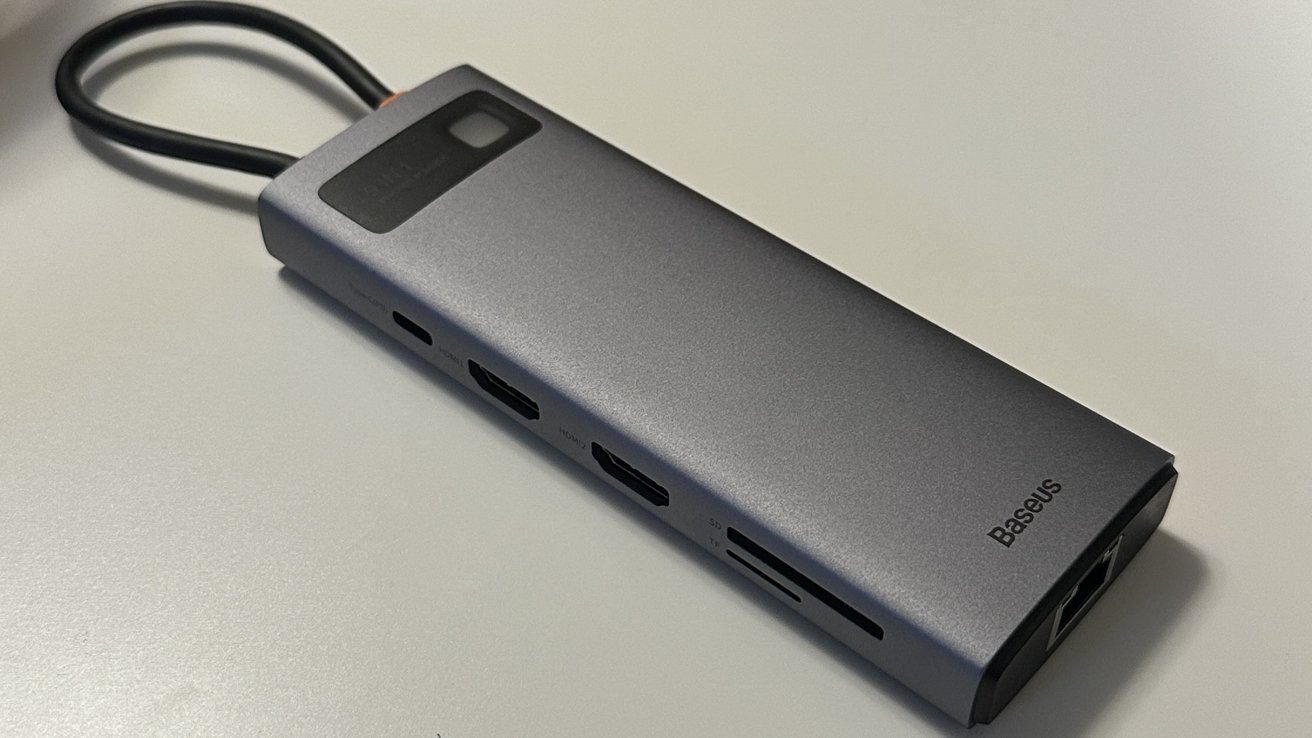
Price:
Starting At $109

For those who value a quality typing experience, it’s safe to say today’s premium keyboard selections are virtually limitless. The Keychron S1 QMK Mechanical Keyboard tries to distinguish itself in a crowded field by offering minimal compromises and considerable customization in a compact frame.
Offering a choice of lighting and hot-swappable switch options, onboard Mac and Windows keyboard layouts, and real-time software control with the open-source VIA software, the Keychron S1 is incredibly versatile. At just 75% the size of a full-size keyboard, the Keychron S1 even manages to provide a comfortable typing experience. However, despite its many assets, the Keychron S1 is not without its frustrations, including the awkward placement of its USB-C port, lack of a wireless option, and finicky software.
Here’s What We Like
- Fast communication rate
- PBT keycaps and metal chassis
- macOS and Windows layouts included
- Hot-swappable switches
- Programmable through QMK/VIA
And What We Don’t
- No wireless option
- Relatively high price
- Slightly crowded key spacing
- Software can be finicky
How-To Geek’s expert reviewers go hands-on with each product we review. We put every piece of hardware through hours of testing in the real world and run them through benchmarks in our lab. We never accept payment to endorse or review a product and never aggregate other people’s reviews. Read more >>
Design and Form Factor

- Body Material: Full CNC machined aluminum
- Plate Material: Steel
- Dimensions (without keycaps): 4.7 x 12.2 x 0.5in (118.4 x 310.4 x 13.7mm)
- Weight: 2.1lb (970g)
- Polling Rate: 1000Hz
- Keycaps: Double-shot PBT low-profile keycaps, not shine-through
- Switches: Gateron Low Profile MX Mechanical
- Backlight: North-facing RGB LED
- Connectivity: USB-C
When you first pick the Keychron S1’s box up, one of the first things you’re likely to notice is how heavy it feels. Extra weight tends to enhance the mechanical keyboard typing experience by providing a solid platform that, among other things, minimizes extraneous movement and vibration.
The Keychron S1 has a CNC 6063 aluminum body, which gives its platform excellent stability, particularly in comparison to other compact keyboards. Many of these other keyboards, even those with heavy bases, can sometimes give off a hollow, echo-like sound when keys are pressed aggressively. Not so with the Keychron S1, which uses sound-absorbing foam to further reduce the potential for unwanted noise and vibration.

While some compact keyboards can go as low as 60% of the scale of full-size keyboards, and some as high as 98%, the Keychron S1 targets more of a middle ground at 75%. Keycaps are the size you would expect, but to achieve the 75% scale, the keys are tightly grouped with no extra surrounding material.
The specific keyboard model I’m reviewing is the S1H3, which features RGB backlighting along with hot-swappable Gateron Low-Profile Brown mechanical switches. The keyboard is also available in other combinations with a simpler white backlight and Red or Blue switch options. Each switch color provides a distinct feel and sound, creating different typing experiences depending on how you customize the board.
Red switches are linear, which feels the same along the entire length of the key press, and makes a somewhat quieter sound. Blue switches are clicky, activating and making a sound even before the key hits the bottom. Brown switches are tactile, which registers as a small bump when the key is activated, making a more muted clicking sound.
In the box, you get the keyboard, USB-C to USB-C cable, USB-C to USB-A adapter, keycap puller, switch puller, two rubber feet, the user manual, a quick start guide, and a switch pin guide. You can buy additional cables, lubricant, a travel pouch, different types of palm rests, and different types of switches from Keychron’s website.
While almost all keyboards perform well on either Windows- or Mac-based computers, keycaps don’t always match up. In a nice touch, the Keychron S1 comes with an additional set of customized keycaps so you can properly optimize key labels for the computer platform of your choice.

By default, the red accent key caps (such as esc and enter) and Mac keycaps are pre-installed, while the black accent key caps (left alt, right alt, Windows, black esc, and the black enter) are included as replacements or alternates. There’s also a physical switch on the rear of the keyboard to swap between customized Windows and Mac layouts.
For testing purposes on various Windows 11-based machines, I switched the keyboard over to Windows. The ultra-thin keycaps are very easy to pull off with the included tool and then pop back on.
Solid Build Quality and Performance

If you know how to type and aren’t using a mechanical keyboard, you’re missing out. The difference in feel and responsiveness of a good mechanical keyboard over standard keyboards is like riding in style in a luxury car versus a bare-bones utility vehicle. The Keychron S1, with its sandwich of aluminum casing, acoustic case foam, PCB, and steel plate offers the type of premium feel you’d expect from a good mechanical keyboard.
Most keyboards have an adjustment period when first using them, but I had few issues transitioning to the Keychron S1. The only real stumbles I had were due to the relative proximity of the keys, which is one of the concessions with a keyboard of this size. Once you get used to the more compact key spacing, however, you should have no problem getting close to the usual typing speed you achieve on a full-size keyboard.
The default keyboard angle is 3 degrees. With the included rubber feet, the rear of the keyboard can be raised to a more ergonomic 6-degree typing angle. While I found this angle fine, I would have greatly preferred the type of retractable feet found on other keyboards that offer at least one extra level of elevation.

Similarly, I found the single USB-C port on the rear of the keyboard and the included USB-C cable an inconvenience for how I have my various workstations set up. I’ve long since transitioned to wireless mechanical keyboards so I have full use of the desk space behind my keyboard. Regardless of where I used it, the cable got in the way.

Of course, the plus side of a wired keyboard is an interference-free, high-speed connection and no concerns over battery life, particularly when making liberal use of the lighting options. Nevertheless, I would have liked to have a wireless option even if it meant an even higher price point.
Despite the Keychron S1’s smaller size, the keyboard retains essential functionality, although you’ll have to make use of the function (fn) key to access the secondary functions of the F1 – F12 keys like play/pause and volume up/down.
The low-profile spherical-angled (PBT LSA) keycaps are very shallow, like a laptop’s. There’s a tiny bit of key wobble if you tap a key off-center, but for normal typing, key presses register true with a surprisingly deep bottom for such shallow keycaps.
Since my keyboard is configured with Brown switches, key presses make a muted clicking sound, so it’s definitely quieter than many other mechanical keyboards. It’s still audible and you still know you’re using a mechanical keyboard, but this configuration is definitely more office-friendly. With that said, the space bar is noisier than the other keys when it bottoms out, but, on the plus side, has no wobble no matter where you press it.
Although my Apple iPhone 14 Pro Max’s built-in microphone makes the keyboard sound louder than it actually is during normal usage, you can hear how the Brown switches sound when recorded up close:
If you opt for RGB backlighting, up to 22 backlight effects are available. You can further adjust the hue, saturation, brightness, and effect speed with the VIA software (discussed in the next section). By default, the keyboard backlight cycles through a rainbow of colors. Since the included keycaps are opaque, you don’t see any of the light shining through the labels, but rather between each of the keys. Personally, I prefer when the letters are illuminated.
VIA: Open-Source Software Experience
The Keychron S1 features open-source firmware with full VIA support, which is a project based on QMK that allows for real-time keyboard control. In other words, instead of needing to reflash the keyboard’s firmware each time you make a change, you can make changes on-the-fly. Of course, should you mess something up, the Keychron S1 allows you to factory reset.
The VIA app, which lets you set keyboard layouts, shortcuts, backlight effects, and more is available for Windows, Mac, and Linux. You can also go to caniusevia.com to access the same functionality from your web browser.
Since the VIA code for the S1 is still awaiting approval from GitHub, it’s not yet automatically recognized, so you need to go through some extra steps to manually download and import the S1 keymap (S1 RGB Version ANSI (US) and S1 White Backlight Version ANSI (US)).
Unfortunately, for me, despite testing on three different Windows 11-based computers, I was unable to get full access to the keyboard to test the VIA programmability and remapping functionality. This appears to be a relatively common issue, as Keychron has a discrete statement about contacting support should you run into such an issue. Regardless, Keychron has an excellent tutorial on how to make use of VIA, and Mark LoProto’s earlier review of the Keychron Q8 indicated no issues for that keyboard, so your own mileage may vary.
Should You Buy the Keychron S1 QMK Mechanical Keyboard?

There’s no denying that the Keychron S1 QMK Mechanical Keyboard achieves a high standard of quality that makes it an excellent choice for those who want to customize their experience without sacrificing performance. On a practical level, however, it’s hard to unequivocally recommend this keyboard.
For one thing, while its compact size is impressive, you save maybe an inch or so of width and less than that in depth versus many tenkeyless keyboards. These boards can offer more comfortable spacing between keys, and even some dedicated media functions, like with the wireless Logitech G915, a personal favorite. The heavy weight of the Keycrhron S1 doesn’t make it an ideal travel companion either, nor does its need for a cable to work, although again, that does eliminate having to keep yet another device charged.
Then there’s the question of price. The Keychron S1 is not outrageously priced for a keyboard of this quality, but if you’re not going to take advantage of its customization options, be it hardware or software, there are more versatile and value-priced mechanical keyboards out there. For instance, the wireless Velocifire TKL02WS is less than half the price.
The Keychron S1 delivers a satisfying overall typing experience, but unless you find its dimensions ergonomically suitable, you really don’t need a 75% scale keyboard. Even if space is at a premium, many tenkeyless keyboards are only slightly larger, even if most don’t offer the same type of customization options.
Price:
Starting At $109
Here’s What We Like
- Fast communication rate
- PBT keycaps and metal chassis
- macOS and Windows layouts included
- Hot-swappable switches
- Programmable through QMK/VIA
And What We Don’t
- No wireless option
- Relatively high price
- Slightly crowded key spacing
- Software can be finicky






